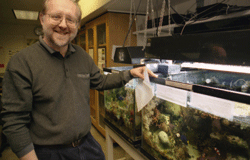News Archives - 1999
Bill Capman: Sharing his passion for biology
 "You think about biology constantly ... this stuff is your life!" a student once remarked to Assistant Professor Bill Capman. He didn't disagree, and his activities in and out of the classroom support it.
"You think about biology constantly ... this stuff is your life!" a student once remarked to Assistant Professor Bill Capman. He didn't disagree, and his activities in and out of the classroom support it.
Capman has spent a great deal of time developing a coral reef aquarium system that boasts well over 100 species of marine organisms visible to the naked eye, and countless others of microscopic proportions.
The most difficult aspect was the time needed for research and experimentation, since techniques for successfully maintaining live corals in a captive environment are not more than a decade or two old and are rapidly evolving.
"Though I had over 30 years of extensive experience with freshwater aquaria and fish breeding, reef systems are quite unlike anything I had worked with in the past," says Capman.
The vision for this reef system began with biology Chair Dale Pederson. Five years ago he approached Capman with a proposal, knowing of Capman's experience with aquaria as well as his great interest and commitment. Capman began with a 20-gallon-tank trial run; when that proved successful, the 130-gallon system was launched in summer 1997. After vexing difficulties with algal blooms, water chemistry and equipment failures, the setup is finally stable and thriving.
"Maintaining a reef tank is like maintaining a garden more than a fish tank. The fish are almost secondary; the needs of the invertebrates--corals, anemones, etc.--are primary," he says. This analogy to a garden is more apt than one might think, since corals and giant clams are fed by symbiotic algae living within their tissues that require adequate and proper lighting.
Now that Augsburg's reef aquarium ecosystem is healthy and stable, it has become increasingly valuable as a research tool. Planned expansion of the reef tanks "will dramatically expand our capacity to do original student-designed research in ecology, animal behavior and even coral biology, complementing what we already do in my ecology course and marine biology field course," says Capman.
Last year Capman designed an internship for Kim New, a biology student who wanted to learn about care and maintenance of a captive coral reef ecosystem. "We learned a lot together, mostly on how not to maintain reef tanks," he quipped. But even the difficulties provided useful learning opportunities for New, who graduated and now works in aqua culture in Hawaii, using the knowledge gained from her internship on a daily basis.
Since casual observation gives little idea of the immense diversity of species in the tanks, Capman encourages students to get up close and really watch. "If somebody shows the slightest interest and I have the time, I'll show them what's going on" he says.
Interpretive materials also help students and visitors appreciate the bio diversity of the reef tanks. Last year, Capman's internship student developed several interpretive displays; this year, four Tri Beta biology honor society students are compiling a color picture key of many of the tanks' species.
Capman has a daughter studying at Seward Montessori School, where he says he serves as "a sort of biology consultant," occasionally taking marine life to her class for students to see and touch. This year he helped Dennis Rains, his daughter's teacher, set up a small marine aquarium by the school's library, using spare equipment and organisms loaned from the biology department. Rains tells that the aquarium helps teach fundamental Montessori concepts, such as the value of bio-diversity. A number of teachers have asked how they can incorporate the marine life into their curricula.
Later this spring seven classes from Seward School will visit Augsburg's biology lab to learn about the coral reef ecosystem. Capman appreciates their visits, since the children eagerly accept his invitation to get up close.